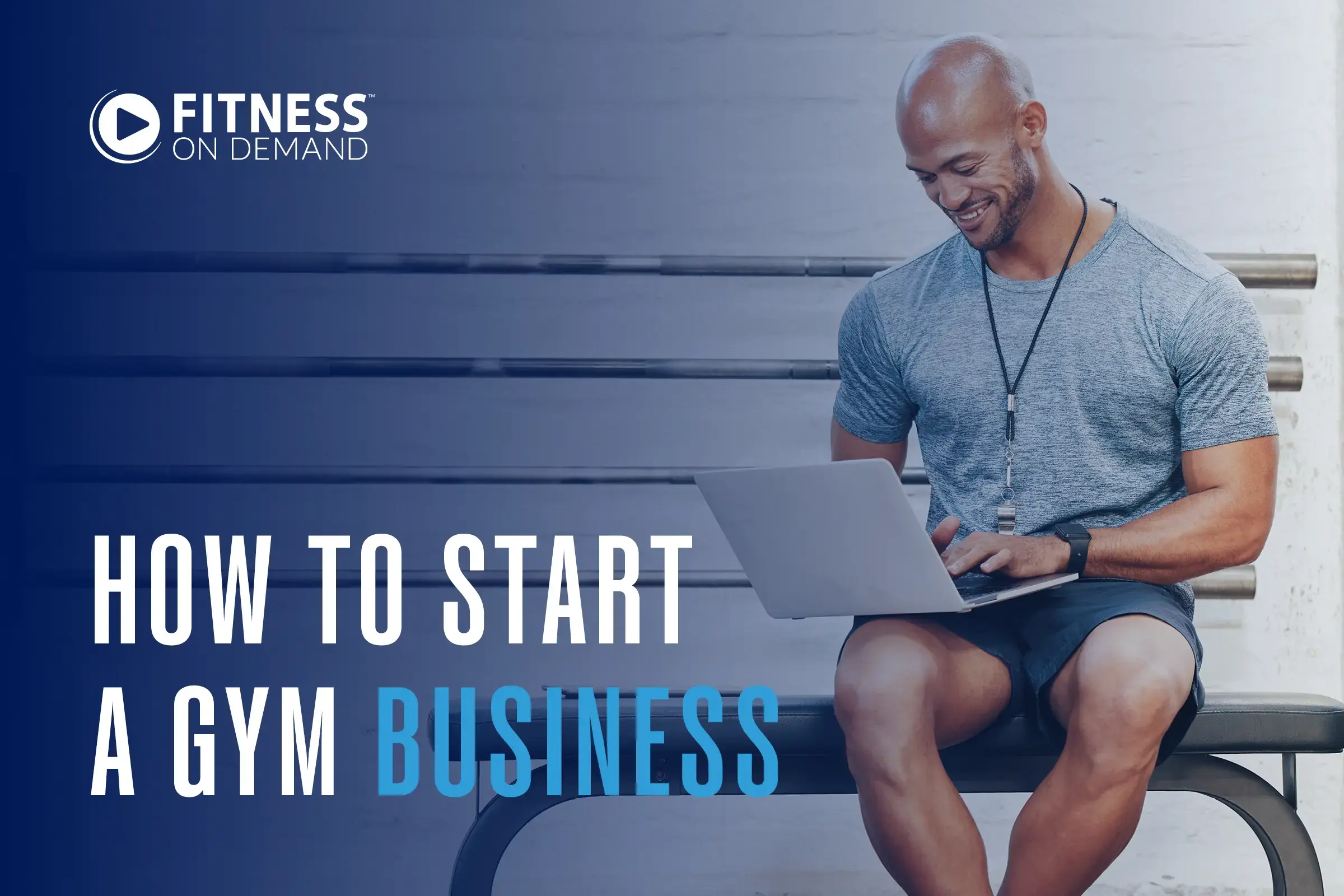Thinking about opening a gym? It’s a bold move, but today’s fitness scene looks much different from even a few years ago.
People want more than equipment and classes. They’re looking for flexibility, digital access, and an experience that fits their lifestyle. If you're considering starting a gym business, it pays to think ahead.

The New Era of Gym Ownership: Why Tech Matters From Day One
Modern gym members expect more — and faster. They want on-demand workouts, flexible memberships, and spaces that feel both high-tech and high-energy. That’s where Fitness On Demand comes in. With smart tools like Broadcast TV, Flex App, and Digital Signage, we help turn traditional gyms into connected, future-ready fitness hubs that stand out from day one.
Below, we’ll walk you through the process of opening a gym and highlight where digital solutions can give your business an edge.
10 Steps: How To Start a Gym Business
Starting a gym is exciting, but setting it apart takes more than fitness gear and good vibes. Whether you’re launching from scratch or rethinking your model, success comes down to how well your gym connects with people and how ready it is to evolve with them.
To simplify things, let’s discuss how to start a gym business with a futuristic mindset using tools like Fitness On Demand to help you engage, scale, and shine from day one.
Step 1: Conduct Market Research and Identify Your Niche
Before spending a dime, understand your target market and analyze competitors. Are you opening in a yoga-loving suburb, a college town, or a downtown core with office workers?
Study the basic gym types. Corporate gyms are company-owned and managed centrally, whereas franchise gyms are owned by individual operators who follow the brand’s established model. Understanding the difference between a corporate gym and a franchise gym can help you decide which business model best aligns with your goals, budget, and preferred level of control.
Define your niche. Whether it’s strength training, CrossFit, group classes, or boutique cycling, your focus should match your audience’s needs. Research fitness trends in your area and ask: What’s missing? What can I do better?
This clarity will guide your branding and help you determine the essential gym features your location must offer, ranging from equipment to digital content.
Step 2: Build a Gym Business Plan That Includes Digital Strategy
Every successful gym begins with a solid roadmap. When mapping your "how to start a gym" business plan, include both standard elements and modern ones:
- Financial projections: Outline expected revenue, expenses, and profit margins. Forecast your gym's financial trajectory for the first few years.
- Startup and operational costs: Break down initial investments (equipment, renovations) and ongoing expenses (rent, utilities, staffing).
- Gym revenue streams: Diversify your income with memberships, retail sales, personal training, demand classes, and special events to guarantee steady cash flow.
- Staffing needs: Define the number and types of staff required (from trainers to front desk personnel) to facilitate a seamless member experience.
- Tech infrastructure: Integrate digital solutions like Fitness On Demand into your business model. The Flex App provides members 24/7 access to workouts. This can boost value, especially for early-stage gyms with limited instructors. Digital Signage can showcase live schedules, promotions, or real-time class stats.
Step 3: Understanding How Profitable Owning a Gym Is
It’s a common question: Is gym ownership worth it? The answer depends on strategy.
Gyms have strong potential for profitability, but only if they’re set up to scale. Profit margins can reach 10% to 30% if your fitness facility keeps overhead low and engagement high.
To boost profitability, start by automating processes wherever possible. Implement gym management software that handles tasks like scheduling, payments, and member check-ins, reducing the need for manual oversight and allowing your staff to focus on more meaningful interactions with members.
Another strategy is to offer tiered memberships. Provide different membership levels, such as basic, premium, and VIP, each with unique benefits. This caters to a wider range of potential clients and allows you to generate more revenue from those who want access to exclusive services.
Finally, use technology to increase gym usage without increasing staff. Digital solutions like on-demand classes, virtual workouts, and smart scheduling systems keep members engaged and coming back without requiring additional personnel. The Fitness On Demand platform supports this by giving members self-guided content anytime, which increases member satisfaction without additional staffing.
Step 4: How Much Does It Cost To Start a Gym Business: Secure Financing
How much does it cost to start a gym business? The upfront cost can vary widely, from $50,000 for a small studio to over $500,000 for a full-scale gym.
Here’s how to create a budget that balances ambition with sustainability:
- Rent or mortgage: Choose a space that fits your needs without stretching your finances. Consider lease terms, location benefits, and future growth.
- Equipment (new or used): Decide whether to buy new for longevity or used for savings, and align your gear with your fitness model.
- Build-out costs: Factor in renovations, flooring, lighting, and any customizations needed to turn your space into a functional fitness facility.
- Staffing: Budget for trainers, front desk staff, and cleaning crews. Don’t forget payroll taxes and benefits if applicable.
- Licensing/insurance: Cover your bases with business permits and liability insurance to protect your gym and members.
- Marketing: Allocate funds for launch promotions, branding, social media ads, and local outreach to attract your target market.
- Digital systems: Plan for gym management software, streaming capabilities, and tools like Fitness On Demand’s Flex App and Broadcast TV. These fitness tech options are an investment that pays off in retention, automation, and engagement.
Step 5: Choose a Strategic Location for Member Growth
Location can make or break your gym. Choose a space that’s convenient for your target audience, has good visibility, and can be adapted for fitness use.
Keep these gym design tips in mind:
- Look for high ceilings if you plan to offer group training.
- Prioritize natural light to create an energizing, welcoming environment.
- Plan for smart traffic flow so members can move between zones without crowding.
- Make room for both in-person and virtual workouts.
With the Flex App from Fitness On Demand, you can offer hybrid fitness options from the start. This allows members who can’t make it in to still be part of your fitness community, no matter where they are.
Step 6: Design the Gym for Hybrid Fitness
Today’s gymgoers expect flexibility and convenience. Designing your space while incorporating hybrid fitness elements helps you meet those expectations and differentiate your gym from the competition.
Create dedicated areas for streaming workouts. These can be compact but should offer privacy and access to strong Wi-Fi. Include quiet corners where members can train using fitness apps on their own schedule. Group rooms should be equipped with TVs or projectors so you can easily offer high-quality on-demand classes.
With Group Studio from Fitness On Demand, you can run scheduled classes even without an instructor present. This gives small or new gyms the power to offer full schedules from the beginning.
Step 7: Offer Membership Models That Reflect Today’s Needs
Standard memberships don’t work for everyone anymore. Today’s fitness consumers expect flexibility and choice. You can meet that demand by offering a variety of pricing models. These might include month-to-month memberships, class packs for casual users, premium tiers with app access, or discounted off-peak pricing.
Fitness On Demand makes each option more valuable. With the Flex App, members can work out when it's most convenient for them. This lets them stay on track with their fitness goals while giving your gym a competitive edge through added convenience and personalization.
Step 8: Equip Your Gym With Smart Tech and Core Gear
Equipment is essential, but so is the tech that supports it. Alongside traditional machines, weights, and mats, invest in:
- Gym management software to handle billing, check-ins, and performance tracking
- TV screens for Digital Signage
- Wi-Fi infrastructure for app usage and streaming
Fitness On Demand turns any screen into a virtual class space. This can help you offer variety, even in small spaces.
Step 9: Build a Tech-Savvy Team
Your team will be the face of your gym, so hire for both attitude and adaptability. Trainers should be open to hybrid training, able to guide members using app-based workouts, and understand how to use digital displays.
Offer regular training to align your team with your tech-forward vision and help them recommend the right features to members.
Step 10: Post-Launch: How To Maximize Profit and Retention Long-Term
After your grand opening, the real challenge is building lasting success. That means consistently measuring performance, responding to member needs, and keeping your offerings fresh.
Start by tracking key gym business metrics like member growth, churn rate, and average revenue per user. Use those insights to adapt your programming based on what’s actually being used.
Then, continue adding value with fresh digital content and meaningful fitness community engagement. Tools like the Flex App, Group Studio, and Digital Signage make this easy by helping you deliver on-demand workouts, share updates instantly, and keep your space dynamic. It’s how modern gyms stay relevant, connected, and profitable long after launch day.
Fitness On Demand: Build a Smart Gym That Grows With You
Building a gym today means thinking digitally at every stage for growth and long-term success. As you move through the steps to start a gym business, let Fitness On Demand be your partner in innovative design, digital integration, and scalable engagement.
Whether you’re looking to differentiate your brand, optimize schedules, or provide more value from day one, Fitness On Demand gives you the edge. Explore how our multiple offerings can modernize your member experience and future-proof your business.
Ready to build a more innovative, flexible fitness facility? Start here with Fitness On Demand.

Author
Andy Peat
Andy Peat is a visionary with a rich background in product innovation, operational management, business expansion, and nearly 20 years of leadership experience in the fitness industry. He spent a couple of years refining his strategic and management skills as the Chief Product Officer at Lift Brands, before pivoting to expand upon his leadership skills and passion for fitness as the CEO of Fitness On Demand.

